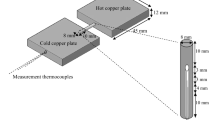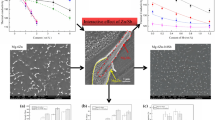Abstract
Low-melting-point alloy has the characteristics of high thermal conductivity, low solidus temperature and the wide range of use temperature, which is a potential heat transfer medium. The microstructure and thermal properties of Sn–Bi–Pb–Zn alloys as heat transfer and storage material were investigated in this paper. The phase compositions, microstructure and thermal properties were investigated by X-ray diffusion (XRD), electron probe microanalysis (EPMA) and differential scanning calorimeter (DSC) analysis, respectively. The results show that the phases of Sn–Bi–Zn and Sn–Pb–Zn alloys are mainly eutectic formed by solid solution, while the formation of Pb7Bi3 intermetallic compounds decreases the melting point of Sn–Bi–Pb and Bi–Pb–Zn. The thermal properties of the zinc-containing alloys are better than that of Sn–Bi–Pb, but the weight of the zinc-containing alloys significantly reduces above 900 °C. As the density, specific heat capacity and thermal diffusivity change with temperature and physical state, the thermal conductivity of the alloys first decreases and then increases. These results demonstrate the feasibility of using low-melting alloys as the heat transfer and storage material.









Similar content being viewed by others
References
Reilly J, Paltsev S, Felzer B, Wang X, Kicklighter D, Melillo J, Prinn R, Sarofim M, Sokolov A, Wang C. Global economic effects of changes in crops, pasture, and forests due to changing climate, carbon dioxide, and ozone. Energy Policy. 2007;35(11):5370.
Vignarooban K, Xu XH, Arvay A, Hsu K, Kannan AM. Heat transfer fluids for concentrating solar power systems—a review. Appl Energy. 2015;146(1):383.
Lorenzin N, Abánades A. A review on the application of liquid metals as heat transfer fluid in concentrated solar power technologies. Int J Hydrogen Energy. 2016;41(17):6990.
Chen YY, Zhao CY. Thermophysical properties of Ca(NO3)2–NaNO3–KNO3 mixtures for heat transfer and thermal storage. Sol Energy. 2017;146(1):172.
Cheng XM, Li G, Yu GM, Li YY, Han JQ. Effect of expanded graphite and carbon nanotubes on the thermal performance of stearic acid phase change materials. J Mater Sci. 2017;52(20):12370.
Zhu C, Cheng XM, Li YY, Tao BM. Influence of heat treatment on solidus temperature of NaNO3–KNO3 molten salt. Sol Energy. 2015;118(1):303.
Pei YZ, Zhou XY, Zhu TJ. Editorial for rare metals, special issue on advanced thermoelectric materials. Rare Met. 2018;37(4):257.
Porteiro J, Miguez JL, Crespo B, Gonzalez LML, De Lara J. Experimental investigation of the thermal response of a thermal storage tank partially filled with different PCMs (phase change materials) to a steep demand. Energy. 2015;91(1):202.
Ben X, Li P, Chan C. Application of phase change materials for thermal energy storage in concentrated solar thermal power plants: a review to recent developments. Appl Energy. 2015;160(1):286.
Ge HS, Li HY, Mei SF, Liu J. Low melting point liquid metal as a new class of phase change material: an emerging frontier in energy area. Renew Sustain Energy Rev. 2013;21(5):331.
Zhang Y, Li PW. Minimum system entropy production as the FOM of high temperature heat transfer fluids for CSP systems. Sol Energy. 2017;152(1):80.
Aksoz S, Ocak Y, Marasli N, Keslioglu K. Determination of thermal conductivity and interfacial energy of solid Zn solution in the Zn–Al–Bi eutectic system. Exp Thermal Fluid Sci. 2011;35(2):395.
Khatib Hisham. IEA World Energy Outlook 2010—a comment. Energy Policy. 2011;39(5):2507.
Fukahori R, Nomura T, Zhu CY, Sheng N, Okinaka N, Akiyama T. Thermal analysis of Al–Si alloys as high-temperature phase-change material and their corrosion properties with ceramic materials. Appl Energy. 2016;163(1):1.
Blanco-Rodriguez P, Rodriguez-Aseguinolaza J, Risueno E, Tello M. Thermophysical characterization of Mg-51%Zn eutectic metal alloy: a phase change material for thermal energy storage in direct steam generation applications. Energy. 2014;75(7):414.
Wang ZY, Wang H, Li XB, Wang DZ, Zhang QY, Chen G, Ren ZF. Aluminum and silicon based phase change materials for high capacity thermal energy storage. Appl Therm Eng. 2015;89(1):204.
Risueno E, Faik A, Rodriguez-Aseguinolaza J, Blanco-Rodriguez P, Gil A, Tello M, D’Aguanno B. Mg–Zn–Al eutectic alloys as phase change material for latent heat thermal energy storage. Energy Procedia. 2015;69(1):1006.
Frazer D, Stergar E, Cionea C, Hosemann P. Liquid metal as a heat transport fluid for thermal solar power applications. Energy Procedia. 2014;49(1):627.
Fang D, Sun Z, Li YY, Cheng XM. Preparation, microstructure and thermal properties of Mg, Bi alloys as phase change materials for thermal energy storage. Appl Therm Eng. 2016;92(1):187.
Kang H, Suh JY, Kang SW, Bae DH. Effect of Sn on thermal conductivity of Mg–5Zn based alloys. Mater Trans. 2015;56(7):1144.
Kaya H, Engin S, Aker A, Buyuk U, Cadirli E. Microstructural, mechanical, electrical, and thermal properties of the Bi–Sn–Ag ternary eutectic alloy. J Wuhan Univ Technol. 2017;32(1):147.
Wang JG, Liu HY, Liu HZ, Fu ZH, Nan D. Facile synthesis of microsized MnO/C composites with high tap density as high performance anodes for Li-ion batteries. Chem Eng J. 2017;328(1):591.
Momeni MM. Dye-sensitized solar cells based on Cr-doped TiO2 nanotube photoanodes. Rare Met. 2017;36(11):865.
Wang JG, Sun HH, Liu HY, Jin DD, Zhou R, Wei BQ. Edge-oriented SnS2 nanosheet arrays on carbon paper as advanced binder-free anodes for Li-ion and Na-ion batteries. J Mater Chem A. 2017;5(1):23115.
Wang JG, Zhang ZY, Zhang XY, Yin XM, Li X, Liu XR, Kang FY, Wei BQ. Cation exchange formation of prussian blue analogue submicroboxes for high-performance Na-ion hybrid supercapacitors. Nano Energy. 2017;39(1):647.
Guo P, Shen Y, Song Y, Ma J, Lin YH, Nan CW. Self-etching Ni-Co hydroxides@Ni-Cu nanowire arrays with enhancing ultrahigh areal capacitance for flexible thin-film supercapacitors. Rare Met. 2017;36(9):691.
Wang JG, Li HZ, Sun HH, Hua W, Wang HW, Liu XR, Wei BQ. One-pot synthesis of nitrogen-doped ordered mesoporous carbon spheres for high-rate and long-cycle life supercapacitors. Carbon. 2018;127(1):85.
Yuan JW, Zhang K, Zhang XH, Li XG, Li T, Li YJ, Ma ML, Shi GL. Thermal characteristics of Mg–Zn–Mn alloys with high specific strength and high thermal conductivity. J Alloy Compd. 2013;578(6):32.
Lan Z, Ma XH, Hao ZL, Jiang R. Experiments on saturated vapor pressure of aqueous lithium bromide solution at high temperatures. Int J Refrig. 2017;76(1):73.
Acknowledgements
This work was financially supported by the National Key Technology Research & Development Program of China (No. 2012BAA05B05), the Key Technology Research & Development Program of Hubei (No. 2015BAA111) and the Fundamental Research Funds for the Central Universities (No.WUT: 2017II23GX).
Author information
Authors and Affiliations
Corresponding author
Rights and permissions
About this article
Cite this article
Wang, QM., Cheng, XM., Li, YY. et al. Microstructures and thermal properties of Sn–Bi–Pb–Zn alloys as heat storage and transfer materials. Rare Met. 38, 350–358 (2019). https://doi.org/10.1007/s12598-019-01206-5
Received:
Revised:
Accepted:
Published:
Issue Date:
DOI: https://doi.org/10.1007/s12598-019-01206-5




